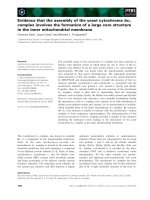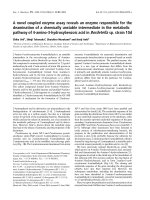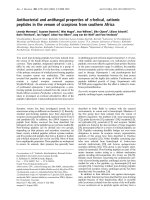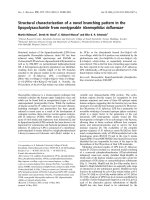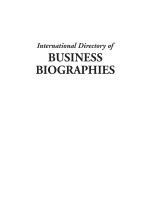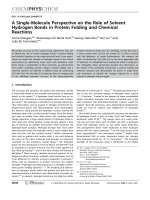E h rodd rodds chemistry of carbon compounds volume 4 six membered heterocyclic compounds with a single nitrogen atom in the ring (rodds chemistry of carbon compounds 2nd edition) (1987)
Bạn đang xem bản rút gọn của tài liệu. Xem và tải ngay bản đầy đủ của tài liệu tại đây (12.12 MB, 477 trang )
Supplements to the 2nd Edition of
RODD'S CHEMISTRY
OF C A R B O N
COMPOUNDS
www.pdfgrip.com
Supplements to the 2nd Edition o f
RODD'S CHEMISTRY
OF
CARBON COMPOUNDS
VOLUME I
ALIPHATIC COMPOUNDS
,k
V O L U M E II
ALICYCLIC COMPOUNDS
V O L U M E III
AROMATIC COMPOUNDS
,k
V O L U M E IV
HETEROCYCLIC COMPOUNDS
VOLUME V
MISCELLANEOUS
GENERAL INDEX
,A,
www.pdfgrip.com
Supplements to the 2nd Edition [Editor S. Coffey) of
RODD'S C H E M I S T R Y OF
CARBON COMPOUNDS
A modern comprehensive treatise
Edited by
MARTIN F. ANSELL
Ph.D., D.Sc. (London) F.R.S.C.C. Chem.
Reader Emeritus, Department of Chemistry,
Queen Mary College, University of London, Great Britain
Supplement to
VOLUME IV HETEROCYCLIC COMPOUNDS
Part G:
Six-Membered Heterocyclic Compounds with a Single Nitrogen Atom
in the Ring to which are Fused Two or More Carbocyclic Ring Systems,
and Six-Membered Ring Compounds where the Hetero-Atom is
Phosphorus, Arsenic, Antimony or Bismuth. Alkaloids Containing a
Six-Membered Heterocyclic Ring System
ELSEVIER
Amsterdam - Oxford - New York - Tokyo 1987
www.pdfgrip.com
ELSEVIER SCIENCE PUBLISHERS B.V.
Sara Burgerhartstraat 25
P.O. Box 211, 1000 AE Amsterdam, The Netherlands
Distributors for the United States and Canada:
ELSEVIER SCIENCE PUBLISHING COMPANY INC.
52, Vanderbilt Avenue
New York, NY 10017
Library of Congress Card Number: 64-4605
ISBN 0-444-42897-6
9 Elsevier Science Publishers B.V., 1987
All rights reserved. No part of this publication may be reproduced, stored in a retrieval system
or transmitted in any form or by any means, electronic, mechanical, photocopying, recording
or otherwise, without the prior written permission of the publisher, Elsevier Science Publishers
B.V./Science & Technology Division, P.O. Box 330, 1000 AH Amsterdam, The Netherlands.
Special regulations for readers in the USA m This publication has been registered with the
Copyright Clearance Center Inc. (CCC), Salem, Massachusetts. Information can be obtained
from the CCC about conditions under which photocopies of parts of this publication may be
made in the USA. All other copyright questions, including photocopying outside of the USA,
should be referred to the publisher.
No responsibility is assumed by the Publisher for any injury and/or damage to persons or
property as a matter of products liability, negligence or otherwise, or from any use or operation
of any methods, products, instructions or ideas contained in the material herein.
Printed In The Netherlands
www.pdfgrip.com
This Page Intentionally Left Blank
www.pdfgrip.com
VI
CONTRIBUTORS TO THIS VOLUME
Kenneth W. Bentley, M.A., D.Sc., D.Phil., F.R.S.E.
Department of Chemistry, Loughborough University,
Loughborough, Leicestershire LEII 3TU
John D. Hepworth, B.Sc., Ph.D., C.Chem., F.R.S.C.
Department of Chemistry, Lancashire Polytechnic,
Preston, Lancashire, PRI 2TO,
Robert Livingstone, B.Sc., Ph.D., F.R.S.C.
Department of Pure and Applied Chemistry, The Polytechnic,
Queensgate, Huddersfield, HDI 3DH
A. Reginald Pinder, D.Sc., Ph.D., D.Phil.
Department of Chemistry, The University,
Clemson, South Carolina, U.S.A.
Malcolm Sainsbury, D.Sc., Ph.D., C.Chem., F.R.S.C.
Department of Chemistry, The University,
Bath, BA2 7 A Y
Raymond E. F a i r b a i r n ,
B.Sc., Ph.D., F.R.S.C.
F o r m e r l y of R e s e a r c h D e p a r t m e n t ,
Dyestuffs Division,
i.c.i.
(INDEX)
www.pdfgrip.com
VII
PREFACE
TO S U P P L E M E N T
IVG
The p u b l i c a t i o n of this v o l u m e c o n t i n u e s the s u p p l e m e n tation of the s e c o n d e d i t i o n of Rodd's C h e m i s t r y of C a r b o n
Compounds, thus k e e p i n g this m a j o r w o r k of r e f e r e n c e u p - t o date.
In this v o l u m e C h a p t e r s 28 to 35 of the s e c o n d e d i t i o n
are b r o u g h t u p - t o - d a t e and the s u p p l e m e n t covers the advances
that have o c c u r r e d in the decade since the p u b l i c a t i o n of
Volume IVG in 1978.
I have been f Q r t u n a t e in that three of the c o n t r i b u t o r s
to the s e c o n d edition, n a m e l y P r o f e s s o r Bentley, P r o f e s s o r
P i n d e r and Dr S a i n s b u r y have again p r o v i d e d v a l u a b l e contributions, as have Dr H e p w o r t h and P r o f e s s o r L i v i n g s t o n e
who have p r e v i o u s l y c o n t r i b u t e d to o t h e r s u p p l e m e n t s to Rodd.
To each of these authors I express my thanks and a p p r e c i a t i o n
for p r o v i d i n g clear, c o n c i s e and i n t e r e s t i n g chapters.
I
also w i s h to thank Dr F a i r b a i r n , who i n d e x e d the second
edition, for again p r o v i d i n g an e x t r e m e l y d e t a i l e d index
w h i c h g r e a t l y f a c i l i t a t e s the use of this book.
At a time w h e n there are many s p e c i a l i s t reviews, monographs and reports available, there is still in my view an
i m p o r t a n t place for a book such as Rodd, w h i c h gives a
b r o a d e r c o v e r a g e of o r g a n i c chemistry.
One aspect of the
value of this w o r k is that it allows the expert in one field
to q u i c k l y find out what is h a p p e n i n g in o t h e r fields of
chemistry.
On the other h a n d a chemist l o o k i n g for the way
into a field of study will find in Rodd an o u t l i n e of the
i m p o r t a n t aspects of that area in c h e m i s t r y t o g e t h e r w i t h
l e a d i n g r e f e r e n c e s to other works to p r o v i d e more d e t a i l e d
information.
This volume has been p r o d u c e d by direct r e p r o d u c t i o n of
the m a n u s c r i p t s .
I am most grateful to the c o n t r i b u t o r s for
all the care and effort b o t h they and their s e c r e t a r i e s have
put into the p r o d u c t i o n of the m a n u s c r i p t s , i n c l u d i n g the
diagrams.
I also w i s h to thank the staff at E l s e v i e r for all
the help they have given me and for seeing the t r a n s f o r m a t i o n
of authors' m a n u s c r i p t s to p u b l i s h e d work.
September
1987
Martin
www.pdfgrip.com
Ansell
This Page Intentionally Left Blank
www.pdfgrip.com
IX
CONTENTS
V O L U M E IV G
Heterocyclic Compounds: Six-Membered Heterocyclic Compounds with a Single Nitrogen Atom
in the Ring to which are Fused Two or More Carbocyclic Ring Systems, and Six-Membered
Ring Compounds where the Hetero-Atom is Phosphorus, Arsenic, Antimony or Bismuth.
Alkaloids Containing a Six-Membered Heterocyclic Ring System
Preface ....................................................................................................................
Official publications; Scientific journals and periodicals .......................................
List of common abbreviations and symbols used ..................................................
Vll
XIII
XIV
Chapter 28. Polycyclic Compounds Comprising a Pyridine and Two or More
Carbocyclic Rings
by J.D. H E P W O R T H
1.
2.
3.
4.
5.
6.
7.
Acridine and its derivatives ...........................................................................
(i) Acridines, l - - (ii) 9,9'-Biacridines, 12 m (iii) Reduced acridines,
14 - - (iv) Acridones, 20 - Phenanthridine and its derivatives ................................................................
(i) Phenanthridines, 31 m (ii) Phenanthridinium salts, 35 m (iii)
Reduced phenanthridines, 38 m (iv) Phenanthridones, 4 0 Benzoquinolines .............................................................................................
(i) Benzo[f]quinolines, 4 8 ~ (ii) Benzo[g]quinolines, 5 3 (iii)
Benzo[h ]quinolines, 58 - - (iv) Benzo[d,e]quinolines, 65 - Benzoisoquinolines ........................................................................................
(i) Benzo[f]isoquinolines, 7 0 - (ii) Benzo[g]isoquinolines, 7 4 - (iii)
Benzo[h ]isoquinolines, 76 - - (iv) Benzo[d,e]isoquinolines, 78 - Benzacridines .................................................................................................
(i) Benz[a]acridines, 81 - - ( i i )
Benz[b]acridines, 8 3 (iii)
Benz[c]acridines, 8 5 (iv) Dibenzo[a,c]acridines, 9 0 (v)
Dibenzo[a,j]acridines
and dibenzo[a,i]acridines,
90 - (vi)
Dibenzo[c,h ]acridines, 91 m
Benzophenanthridines ....................................................................................
(i) Benzo[c]phenanthridines, 9 4 - (ii) Benzo[a]phenanthridines and
benzo[b]phenanthridines, 9 9 - - (iii) Benzo[i]phenanthridines, 100
(iv) Benzo[k]phenanthridines, 101 - Naphthoquinolines and naphthoisoquinolines ..............................................
(i) Naphtho[2,3-g]quinolines, 103 - - (ii) Naphtho[2,l-f]quinolines, 103
- - (iii) Naphtho[l,2-h]quinolines, 106 - - (iv) Naphtho[2,1-f]isoquinoline, 106m (v) Naphtho[l,2-h]isoquinolines, 108 - - (vi)
Naphtho[2,3-h ]isoquinolines, 108 - - (vii) Naphtho[ 1,8-fg]quinolines,
109
www.pdfgrip.com
30
48
70
80
93
102
X
Chapter 29. Six-Membered Heterocycles Containing Phosphorus, Arsenic,
Antimony, and Bismuth as a Single Heteroatom
by R. L I V I N G S T O N E
Introduction ...................................................................................................
Phosphorus c o m p o u n d s .................................................................................
(a) P h o s p h o r i n a n e ( p h o s p h a c y c l o h e x a n e , h e x a h y d r o p h o s p h a b e n z e n e ) and
its derivatives .........................................................................................
(i) Phosphorinanes, 111 m (ii) P h o s p h o r i n a n o n e s , 116 m (iii)
Phosphorinanols, 1 1 9 m
(b) D i h y d r o - a n d t e t r a h y d r o - p h o s p h o r i n s ...................................................
(c) Phosphorins, phosphabenzene, p h o s p h i n i n e .........................................
(d) P h o s p h i n o l i n e s a n d d i b e n z o p h o s p h o r i n s ..............................................
(i) Phosphinolines, phosphanaphthalenes, benzophosphorins, 135 ~ (ii)
Dibenzo[b,e]phosphorins (9-phosphaanthracenes), 141 ~ (iii) Dibenzo[b,d]phosphorins
(9-phosphaphenanthrene),
144
~
(iv)
P h o s p h a p h e n a l e n e derivatives, 145
Arsenic c o m p o u n d s ........................................................................................
(a) Arsabenzene (arsenin) and its derivatives ..............................................
(i) Arsabenzenes, 146 m (ii) Derivatives of arsabenzene possessing a
functional group, 150
(b) Arsanaphthalenes (benzoarsenins) .........................................................
(c) D i b e n z o a r s e n i n s .....................................................................................
(i)
Dibenzo[be]arsenins
(arsaanthracenes),
157
~
(ii)
Dibenzo[bd]arsenin, 160
(d) Miscellaneous heterocycles containing an arsabenzene ring ..................
A n t i m o n y c o m p o u n d s ....................................................................................
(a) M o n o n u c l e a r c o m p o u n d s .......................................................................
(b) Fused ring c o m p o u n d s ...........................................................................
Bismuth c o m p o u n d s .......................................................................................
1.
2.
3.
4.
111
111
111
120
122
135
146
146
156
157
161
162
162
164
166
Chapter 30. Pyridine and Piperidine Alkaloids
by M. S A I N S B U R Y
~
2.
3.
4.
5.
6.
7.
8.
9.
10.
11.
12.
Alkaloids from the Achillea and Piper genera .......... ......................................
Miscellaneous N-acylpiperidine alkaloids ......................................................
Sedum alkaloids ..............................................................................................
The alkaloids of Prosopis and Cassia species .................................................
Alkaloids of tobacco .......................................................................................
Alkaloids from p a p a y a ...................................................................................
Nuphar alkaloids ..................................................................... . ............... ........
Miscellaneous piperidines and pyridines f r o m plant sources ........................
Fungal metabolites .........................................................................................
Piperidine and pyridine bases from insects ...................................................
(a) Ant v e n o m s ............................................................................................
(b) Bases from bugs and beetles .............................................................. . ....
The p u m i l o t o x i n s ...........................................................................................
Pyridines from m a r i n e organisms ..................................................................
www.pdfgrip.com
169
173
174
179
183
185
187
189
197
199
199
202
203
207
XI
Chapter 31. The Quinoline Alkaloids
by M. S A I N S B U R Y
1.
2.
3.
K n o w n q u i n o l i n e s from m i c r o - o r g a n i s m s a n d higher plants .........................
N e w a l k a l o i d s .................................................................................................
(a) S i m p l e q u i n o l i n e s a n d 4 - q u i n o l i n o n e s ...................................................
(b) 2 - Q u i n o l i n o n e s .......................................................................................
(c) N e w f u r o q u i n o l i n e a n d d i h y d r o f u r o q u i n o l i n e a l k a l o i d s .......................
N o n - r u t a c e o u s m i s c e l l a n e o u s a l k a l o i d s .........................................................
209
217
217
222
235
243
Chapter 32. The Acridine Alkaloids
by M. S A I N S B U R Y
1.
2.
N e w a l k a l o i d s .................................................................................................
A c r o n y c i n e d i m e r s a n d t r i m e r s ......................................................................
247
257
Chapter 33. The Isoquinoline Alkaloids
by K.W. B E N T L E Y
1.
2.
3.
4.
5.
6.
7.
8.
9.
10.
11.
12.
13.
14.
15.
16.
17.
18.
19.
20.
S i m p l e i s o q u i n o l i n e s , d i h y d r o - a n d t e t r a h y d r o i s o q u i n o l i n e s ........................
B e n z y l i s o q u i n o l i n e s .......................................................................................
B i s b e n z y l i s o q u i n o l i n e s ...................................................................................
C u l a r i n e s ........................................................................................................
A p o r p h i n e s .....................................................................................................
P a v i n e s a n d i s o p a v i n e s ..................................................................................
B e n z o p y r r o c o l i n e s ..........................................................................................
B e r b e r i n e s a n d t e t r a h y d r o b e r b e r i n e s .............................................................
A z a b e r b e r i n e s .................................................................................................
S e c o b e r b e r i n e s ................................................................................................
P r o t o p i n e s ......................................................................................................
P h t h a l i d e i s o q u i n o l i n e s ...................................................................................
S p i r o b e n z y l i s o q u i n o l i n e s ...............................................................................
I n d a n o b e n z a z e p i n e s .......................................................................................
R h o e a d i n e s .....................................................................................................
O t h e r m o d i f i e d b e r b e r i n e s .............................................................................
B e n z o p h e n a n t h r i d i n e s ....................................................................................
I p e c a c u a n h a alkaloids ....................................................................................
P h e n y l e t h y l i s o q u i n o l i n e s ...............................................................................
C o l c h i c i n e a n d its a n a l o g u e s ..........................................................................
259
265
271
280
283
295
297
298
306
307
311
313
318
321
326
328
332
340
344
345
Chapter 34. Diterpenoid Alkaloids
by A.R. P I N D E R
I n t r o d u c t i o n ...................................................................................................
X - r a y d i f f r a c t i o n analysis ...............................................................................
Mass s p e c t r o m e t r y ..........................................................................................
N m r s p e c t r o s c o p y ...........................................................................................
(a) P r o t o n m a g n e t i c r e s o n a n c e s p e c t r o s c o p y ..............................................
(b) C a r b o n - I 3 m a g n e t i c r e s o n a n c e s p e c t r o s c o p y ........................................
www.pdfgrip.com
349
350
353
356
356
357
XII
Chapter 35. Steroidal Alkaloids
by A.R. P I N D E R
I n t r o d u c t i o n ...................................................................................................
1.
Apocynaceae a l k a l o i d s ....................................................................................
(a)
(b)
(c)
(d)
(e)
2.
3.
4.
5.
6.
7.
8.
9.
3 - A m i n o s t e r o i d s .....................................................................................
2 0 - A m i n o s t e r o i d s ...................................................................................
3 , 2 0 - D i a m i n o s t e r o i d s ............................................................................
3 - A m i n o c o n a n i n e s ( c o n e s s a n e s ) ............................................................
M i s c e l l a n e o u s a l k a l o i d s ..........................................................................
Salamandra a l k a l o i d s .....................................................................................
Buxus a l k a l o i d s ...............................................................................................
Pachysandra a l k a l o i d s ....................................................................................
Solanum a l k a l o i d s ..........................................................................................
(a) S p i r o s o l a n e a l k a l o i d s ..............................................................................
(b) A l k a l o i d s r e l a t e d to 2 0 - p i p e r i d y l - 5 a - p r e g n a n e ......................................
(c) A l k a l o i d s r e l a t e d to 2 2 - p y r r o l i d y l - 5 c ~ - p r e g n a n e .....................................
(d) A l k a l o i d s c o n t a i n i n g a n i n d o l i z i d i n e u n i t ..............................................
(e) M i s c e l l a n e o u s a l k a l o i d s ..........................................................................
Veratrum a n d Fritillaria a l k a l o i d s ..................................................................
(a) P i p e r i d y l p r e g n a n e a n d i n d o l i z i d i n e a l k a l o i d s ........................................
(b) C - N o r - D - h o m o s t e r o i d a l a l k a l o i d s ..........................................................
(i) A l k a m i n e s , 415 m (ii) E s t e r - a l k a l o i d s , 4 1 9
Asclepiadaceae a l k a l o i d s .................................................................................
M i s c e l l a n e o u s s t e r o i d a l a l k a l o i d s ...................................................................
B i o s y n t h e s i s o f s t e r o i d a l a l k a l o i d s .................................................................
I n d e x .......................................................................................................................
www.pdfgrip.com
393
394
394
395
396
397
399
399
402
405
406
406
408
409
411
412
413
413
415
420
421
423
429
XIII
O F F I C I A L PUBLICATIONS
B.P.
F.P.
British
French
(United
Patent
G.P.
German
Patent
Sw.P.
U.S.P.
U.S.S.R.P.
B.I .O.S.
Swiss Patent
United States
Patent
Russian
Patent
British
Intelligence
Objectives
Sub-Committee
Reports
Field
Information
Agency, Technical
Reports
of U.S. Group Control
Council
for Germany
British
Standards
Specification
American Society
for Testing
and .~aterials
American Petroleum
Institute
Projects
Colour
Index Number of Dyestuffs
and Pigments
F.I.A.T.
B.S.
A.S.T.M.
A.P.I .
C.I.
SCIENTIFIC
Kingdom)
Patent
JOURNALS AND PERIODICALS
With few obvious
and self-explanatory
abbreviations
used in references
to
comprising
the extensive
literature
are those used in the World List
of
modifications
the
journals
and periodicals
on o r g a n i c
chemistry,
Scientific
Periodicals.
www.pdfgrip.com
XIV
LIST
A
Ac
a
as, asymm.
at
B
Bu
b.p.
C, mC and UC
c, C
C.D.
conc.
crit.
D
D
D
DL
d
dec. or
deriv.
E
E 1 , E2
ElcB
e.s.r.
Et
e
f
f.p.
G
g.I .c.
g
H
h
Hz
I
i.r~
J
K
kJ
decomp.
OF
COMMON
ABBREVIATIONS
SYMBOLS
USED
AND
acid
~ngstr6m units
acetyl
axial;
antarafacial
asymmetrical
atmosphere
base
butyl
boiling
point
curie,
millicurie
and microcurie
concentration
circular
dichroism
concentrated
critical
-18
Debye
unit,
1 x I0
e.s.u.
dissociation
energy
dextro-rotatory;
dextro
configuration
optically
inactive
(externally
compensated)
density
with decomposition
derivative
energy;
extinction;
electromeric
effect;
Entgegen
(opposite)
configuration
uni- and bi-molecular
elimination
mechanisms
unimolecular
elimination
in conjugate
base
electron
spin resonance
ethyl
nuclear
charge;
equatorial
oscillator
strength
freezing
point
free energy
gas liquid
chromatography
spectroscopic
splitting
factor,
2.0023
applied
magnetic
field;
heat content
Planck's
constant
hertz
spin quantum
number;
intensity;
inductive
effect
infrared
coupling
constant
in n.m.r,
spectra;
joule
dissociation
constant
kilojoule
www.pdfgrip.com
XV
LIST
k
OF
COMMON
ABBREVIATIONS
Boltzmann
constant;
velocity
constant
kilocalories
laevorotatory;
laevo
configuration
molecular
weight;
molar;
mesomeric
effect
methyl
mass;
mole;
molecule;
metamillilitre
melting
point
mesyl
(methanesulphonyl)
molecular
rotation
Avogadro
number;
normal
nanometre
(10 -9 metre)
nuclear
magnetic
resonance
normal;
refractive
index;
principal
quantum
number
kcal
L
M
Me
m
ml
m.p.
Ms
EM~
N
nm
n.m.r.
n
0
ortho-
o.r.d.
optical
rotatory
dispersion
polarisation,
probability;
orbital
propyl
phenyl
p a r a - ; orb i t al
proton
magnetic
resonance
clockwise
configuration
counterclockwise
config. ; entropy,
of incompleted
electronic
shells;
orbital
state
uni- and bi-molecular
nucleophilic
stitution
mechanisms
internal
nucleophilic
substitution
isms
P
Pr
Ph
P
p.m.r.
R
S
SNI,
SN 2
SNi
s
sec
soln.
symm.
T
Tosyl
Trityl
t
temp.
tert .
U
u.v.
v
Z
symmetrical;
orbital;
suprafacial
secondary
solution
symmetrical
absolute
temperature
p-tol uen e sul phonyl
triphenylmethyl
time
temperature
(in degrees
centigrade)
tertiary
potential
energy
ultraviolet
velocity
zusammen
(together)
configuration
www.pdfgrip.com
state
net
spin
submechan-
XVI
LIST OF COMMON ABBREVIATIONS
~A
CCE
~B
~g
l)
X ,•
(+)
(-)
(+)
0
@
,X~
optical rotation (in water unless otherwise
stated)
specific optical rotation
atomic susceptibility
electronic susceptibility
dielectric constant; extinction coefficient
microns (lO -4 cm); dipole moment; magnetic
moment
Bohr magneton
microgram (lO -6g)
wavelength
frequency; wave number
magnetic, diamagnetic and paramagnetic
susceptibilities
about
dextrorotatory
laevorotatory
racemic
negative charge
positive charge
www.pdfgrip.com
Chapter 28
POLYCYCLIC COMPOUNDS COMPRISING A PYRIDINE AND TWO OR
MORE CARBOCYCLIC RINGS
J.D. HEPWORTH
I.
Acridine and its derivatives
The widespread
is
reflected
chemistry
1980,
T. Brychcy,
and
Z.
in
(S.
14,
interest
the
in acridine
reviews
Skonieczny,
which
biological
Mutat.
Res., 1979, 65,
in
J.M.
their
Polak,
occurrence
Wiley,
to
1977,
activity
(A. Nasim
261 and M.R.
Science'
Chichester,
in alkaloids
their
6,
'Histochemist ry:
Horizons in Applied Biomedical
and
relate
Heterocycles,
985),
Darzynkiewicz
and its derivatives
p.
(M.F. Grundon,
and
Melamed
Widening
ed. P.J.
1981,
987
Stoward
237)
Nat.
and
Prod.
Rep., 1985, 2, 393).
(i)
Acridines
The
principal
formation
although
synthetic
route
to
of the C-9 - C-9a bond
the
exact
nature
and
acridines
7
source
to the heteroatom,
of
acridine precursor varies quite appreciably.
www.pdfgrip.com
involves
the
immediate
A
range
of
derivatives
obtained
by
the
acid
of
2-nitroacridine
catalysed
arylamino-5-nitrobenzaldehydes
through
protonation
of the
and J.F.K. Wilshire,
It is of interest
substituent
cyclisation
which
probably
carbonyl
Austral.
group
J. Chem.,
been
of
2-
proceeds
(J. Rosevear
1981, 34, 839).
to note that the presence
of a
meta-
arylamino moiety
leads predominantly
to the 6-substituted 2-nitroacridine;
only a small amount
of
the
in the
has
8-isomer
is
produced.
Electron
withdrawing
substituents markedly decrease the rate of cyclisation in
trifluoroacetic
acid.
groups
as
is
not
accelerates
group
has
under
the
The effect
simple,
cyclisation,
a
retarding
strongly
a
for
of electron releasing
whilst
a
dimethylamino
effect.
acidic
It
or
seems
conditions
methyl
group
a methoxy
certain
used
to
that
effect
cyclisation the amine function is protonated and perhaps
the methoxy group is similarly affected.
02N / ~ _CHO 02N~CHO
NHAr
(i) ArNH2, DMSO, Et3N ;
~ ~ /
(ii) CF3COOH
Electron rich 2-arylaminoacetophenones
alumina
1983,
the
(B. Kasum
36,
1455)
and
and
of
W.A.
amides
Denny,
cyclise readily on
Prager,
and polyphosphoric
cyclodehydration
(D. Chambers
R.H.
R
Austral.
ethyl
(I)
J.
www.pdfgrip.com
ester
Chem.,
effects
to 9-aminoacridines
chem.
1986, 1055).
J.
Soc.
Perkin
I,
~CONHPr
pPE
.
f
NH
NHPr
~
NO2
N(CH2CH 20Ac ) 2
(AcOCH2CH2 ) 2N~
NO2
(1)
3-Acyl- 2,5-bis (arylamino) -I, 4-benz oquinones
cyclisation
in
either
sulphuric
acid
(2)
or
undergo
methanolic
hydrogen chloride to yield acridinequinones (3) (K. Joos,
M. Pardo and W. Schafer,
4901).
J. chem. Research
(M), 1978,
2-Methoxyacridine is the starting point for the
synthesis
of
both
acridine-l, 4-diones
corresponding 1,2-quinones (J. Renault
and
et al.,
the
Eur. J.
Med. Chem.-Chim. Ther., 1981, 16, 24).
0
0
R
A
MeOH
NHAr
MeO
X
HCI
0
0
MeOH//
HC1/ / ArNH2
0
A
r
N
R
H
~
X
(3)
www.pdfgrip.com
Cyclisation of 4-chloro-N-(3-nitrophenyl)anthranilic
acid
(4) by means of phosphorus oxychloride gives a mixture of
1- and 3-nitro-6,9-dichloroacridine.
The 1-isomer reacts
selectively with pyridine to give the 9-pyridinium salt
and
hence
separation
(B. Wysocka-Skrzela,
Chem.,
1977, 51,
of
the
isomers
is
possible
K. Biskup and A. Ledochowski, Rocz.
2411).
The 9-chlorine
atom
in each
isomer is exclusively displaced by phenol~ the resulting
9-phenoxy
substituent
is
also
labile.
reaction with mono-Boc-protected
di-
and
tri-
9-acridyl
amines
derivatives
polyamines to be prepared
(5,
For
example.
enables
6
and
mono-,
7)
of
(J.B. Hansen and O. Buchardt,
Chem. Comm., 1983, 162) and several 9-acridylamino acids
have
been
obtained
Wysocka-Skrzela,
from
l-nitro-9-phenoxyacridine
G. Weltrowska
and A. Ledochowski,
(B.
Pol.
J. Chem., 1980, 5__44,619).
NH(CII2)nNH2
C l ~
COOH
NO
2
(4)
(5)
www.pdfgrip.com
~
N
NH
I
(~H2)n
NH
HN/~/
(6)
(7)
2,9-Dimethylacridine
methyldiphenyl~aine
results
from
the
reaction
of
4-
with acetic acid in the presence of
zinc chloride; the route involves decarbo~lation
of N-p-
tolylanthranilic acid, itself a precursor of the acridine
ring system (J.R. Patton and K.H. Dudley. J. heterocyclic
C~em.,
1979,
16, 257).
It is ~ s o
of interest to note
that C-9 of acridine can be introduced
vapour
phase
(R.E. Busby
reaction
of
c~oroform
directly by the
and
diphenylmnine
et al., J. ch~,. Research (M), 1980, 4935).
co::
CuCO
225~
NH
Me
CH3C~H, ZnC12
220~
www.pdfgrip.com
Flash
vacuum
affords
a
pyrolysis
mixture
derivative,
of
of
2-azidodiphenylmethane
acridine
and
its
(8)
9,10-dihydro
the composition of the product varying with
the reaction temperature
(M.G. Hicks and G. Jones, Chem.
Comm., 1983, 1277).
Temp
% composition
(~
acridine
9, lO-dihydro
350
10
90
500
33
66
700
95
5
(8)
Both a dihydroacridine
and an acridine
thermolysis of 2-azidotriphenylmethanes
result
from the
(9) (R.N. Carde
et al., J. chem. Soc. Perkin I, 1978, 1211; 1981, 1132).
In
an
(I0),
analogous
generated
tosylhydrazone
manner,
in
2,(phenylamino)phenylcarbenes
the
sodium
vapour
salts,
phase
insert
from
into
the
the
adjacent ortho-position although giving only the dihydro
derivative
(W. D. Crow and H. McNab, Austral.
J. Chem.,
1981, 34, 1037).
...=..
H
p-MeOC 6 H4
CH
R
(9)
"NH
(i0)
www.pdfgrip.com
Me
(II)
The quinone methide
Diels-Alder
reaction
when heated with
include
the
(13) both
pyrolysis
derived from flavan by a retro-
gives only
aniline.
However,
diphenylmethane
of which
a 4% yield of acridine
yield
(12) and
the
(J.L. Asherson,
the other products
the Mannich base
tricyclic
compound
upon
O. Bilgic and D.W. Young,
J.
chem. Soc. Perkin I, 1980, 522).
A " I~
~ph
CH20
'
PhNH2
(11)
+
OH
OH NH2
(12)
Both
(13)
2- N -phenyl aminobenzyl
alcohol
and
l-
phenylbenzoxazine (14) break down to the azaxylylene (15)
at
high
silica
or
alumina the reaction temperature is reduced from 650~
to
400~
temperatures;
in
Electrocyclisation
dihydroacridine
with
some
the
of
presence
the
acridine,
of
azaxylylene
the
gives
extent
dehydrogenation increasing at temperatures over 650~
of
(I.
Hodgetts, S.J. Noyce and R.C. Storr, Tetrahedron Letters,
1984, 5435).
(14)
(15)
www.pdfgrip.com
Alkylation of acridine at C-9 occurs on reaction with
~-
alkoxyalkyl lithium compounds and subsequent oxidation of
the
resul ring
9,10-dihydroacridine
Various
functional
leading
notably
group
to
derivative
interconversions
acridines
are
bearing
(16).
possible
phosphorus
containing substituents at the 9-position (L. Hornet and
W. Hallenbach, Phosphorus and Sulphur, 1984, 20, 173).
(CH2 )nOR
O
.~,
FeCl 3
H
(16)
Cyclisation
of
2-carboxytriphenylamines
by
phosphorus
oxychloride
provides access to 9-amino-10-arylacridinium
salts
the
v~G
9-chloro
D.H. Birtwistle
and P.B.
derivatives
Wyatt,
J.
chem.
(R. M.
Acheson,
Research
(M),
1986, 2762).
An alternative approach to 9-substituted acridinium salts
and
thence
conversion
the
corresponding
of
acridines
9-acridones
involves
into
the
the
9-
trifluoromerhanesulphonyloxy
acridinium salts (17), which
react readily with halides,
pseudohalides
and isothiocyanate,
and sulphur nucleophiles
and G. Maas, Z. Naturforsch.,
base
results
on
9,9'-Bisacridine
such as azide
reaction
ethers
1984, 39b, 1399).
with
are
(B. Singer
The free
diisopropylethylamine.
also
methodology.
www.pdfgrip.com
available
by
this
